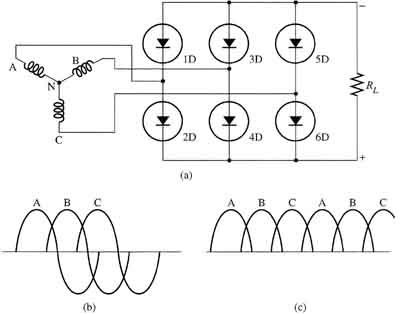AMAZON multi-meters discounts AMAZON oscilloscope discounts
Most industrial power supplies for motor drives and welding applications use three-phase ac voltage. This means that the rectifier for these circuits must use a three-phase bridge, which has six diodes to provide full-wave rectification (two diodes for each line of the three phases). Fig. 1 shows the electrical diagram for a three-phase bridge rectifier. From this diagram, notice that the secondary winding of a three-phase transformer is shown connected to the diode rectifier. Phase A of the three-phase voltage from the transformer is connected to the point where the cathode of diode 1D is connected to the anode of diode 2D. Phase B is connected to the point where the cathode of diode 3D is connected to the anode of diode 4D, and phase C is connected to the point where the cathode of diode 5D is connected to the anode of diode 6D. The anodes of diodes 1D, 3D, and 5D are connected together to provide a common point for the dc negative terminal of the output power. The cathodes of diodes 2D, 4D, and 6D are connected to provide a common point for the dc positive terminal of the output power.

Above: Fig. 1 (a) Electronic schematic of the three-phase bridge rectifier
that is connected to the secondary winding of a three-phase transformer.
(b) Three-phase input sine waves. (c) Six half-waves for the dc output.
A good rule-of-thumb for determining the connections on diode rectifiers is that the ac input voltage will be connected to the bridge where the anode and cathode of any two diodes are joined. Since this occurs at two points in the bridge, in a four diode bridge the two ac lines will be connected there without respect to polarity since the incoming ac voltage does not have a specific polarity. The positive terminal for the power supply will be connected to the bridge where the two cathodes of the diodes are joined, and the negative terminal will be connected to the bridge where the two anodes of the diodes are joined.
This diagram also shows the waveforms for the three-phase sine waves that supply power to the bridge, and for the six half-waves of the output pulsing dc voltage. Notice that since the six half-waves overlap, the dc voltage does not have a chance to get to the zero voltage point; thus, the average dc output voltage is very high.
The three-phase full-wave bridge rectifier is used where the required
amount of dc power is high and the transformer efficiency must be high.
Since the output waveforms of the half-waves overlap, they provide a low
ripple percentage. In this circuit, the output ripple is six times the
input frequency. Since the ripple percentage is low, the output dc voltage
is usable without much filtering. This type of rectifier is compatible
with transformers that are wye or delta connected.

